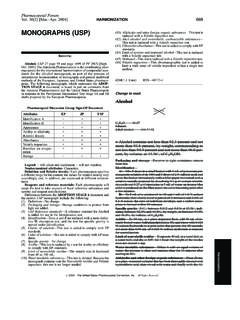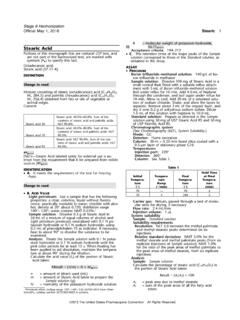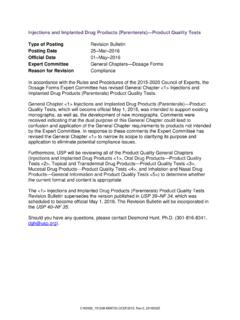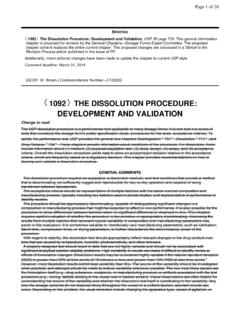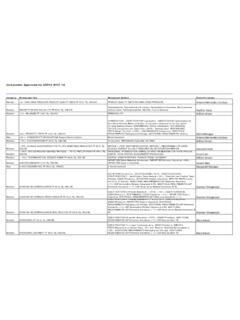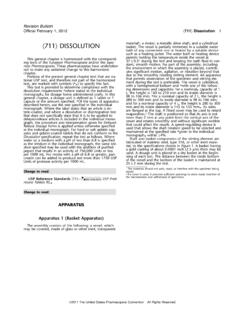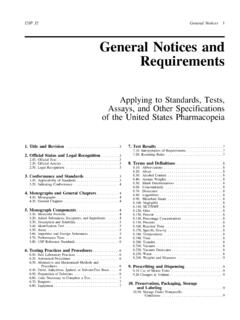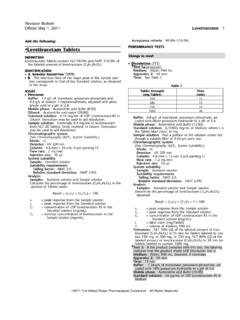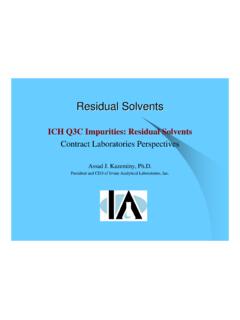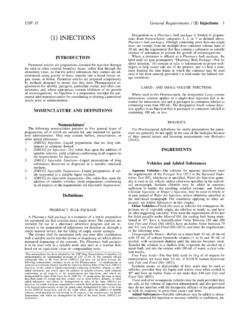Transcription of <788> PARTICULATE MATTER IN INJECTIONS - uspnf.com
1 <788> PARTICULATE MATTER IN INJECTIONS PARTICULATE MATTER in INJECTIONS and parenteral infusions consists of mobile undissolved particles, other than gas bubbles, unintentionally present in the solutions. For the determination of PARTICULATE MATTER , two procedures, Method 1 (Light Obscuration Particle Count Test) and Method 2 (Microscopic Particle Count Test), are specified hereinafter. When examining INJECTIONS and parenteral infusions for sub-visible particles Method 1 is preferably applied. However, it may be necessary to test some preparations by the light obscuration particle count test followed by the microscopic particle count test to reach a conclusion on conformance to the requirements.
2 Not all parenteral preparations can be examined for sub-visible particles by one or both of these methods. When Method 1 is not applicable, in case of preparations having reduced clarity or increased viscosity, the test should be carried out according to Method 2. Emulsions, colloids, and liposomal preparations are examples. Similarly, products that produce air or gas bubbles when drawn into the sensor may also require microscopic particle count testing. If the viscosity of the preparation to be tested is sufficiently high so as to preclude its examination by either test method, a quantitative dilution with an appropriate diluent may be made to decrease viscosity, as necessary, to allow the analysis to be performed.
3 The results obtained in examining a discrete unit or group of units for PARTICULATE MATTER cannot be extrapolated with certainty to other units that remain untested. Thus, statistically sound sampling plans must be developed if valid inferences are to be drawn from observed data to characterize the level of PARTICULATE MATTER in a large group of units. METHOD 1. LIGHT OBSCURATION PARTICLE COUNT TEST Use a suitable apparatus based on the principle of light blockage which allows an automatic determination of the size of particles and the number of particles according to size. The definition for particle-free water is provided in Reagent Specifications under Reagents, Indicators and Solution section.
4 The apparatus is calibrated using dispersions of spherical particles of known sizes between 10 m and 25 m, USP Particle Count Reference Standard. These standard particles are dispersed in particle-free water. Care must be taken to avoid aggregation of particles during dispersion. General precautions The test is carried out under conditions limiting PARTICULATE MATTER , preferably in a laminar-flow cabinet. Very carefully wash the glassware and filtration equipment used, except for the membrane filters, with a warm detergent solution and rinse with abundant amounts of water to remove all traces of detergent.
5 Immediately before use, rinse the equipment from top to bottom, outside and then inside, with particle-free water. Take care not to introduce air bubbles into the preparation to be examined, especially when fractions of the preparation are being transferred to the container in which the determination is to be carried out. In order to check that the environment is suitable for the test, that the glassware is properly cleaned and that the water to be used is particle-free, the following test is carried out: determine the PARTICULATE MATTER in 5 samples of particle-free water, each of 5 mL, according to the method described below.
6 If the number of particles of 10 m or greater size exceeds 25 for the combined 25 mL, the precautions taken for the test are not sufficient. The preparatory steps must be repeated until the environment, glassware and water are suitable for the test. Method Mix the contents of the sample by slowly inverting the container 20 times successively. If necessary, cautiously remove the sealing closure. Clean the outer surfaces of the container opening using a jet of particle-free water and remove the closure, avoiding any contamination of the contents. Eliminate gas bubbles by appropriate measures such as allowing to stand for 2 min or sonicating.
7 For large-volume parenterals, single units are tested. For small-volume parenterals less than 25 mL in volume, the contents of 10 or more units is combined in a cleaned container to obtain a volume of not less than 25 mL; the test solution may be prepared by mixing the contents of a suitable number of vials and diluting to 25 mL with particle-free water or with an appropriate particle-free solvent when particle-free water is not suitable. Small-volume parenterals having a volume of 25 mL or more may be tested individually. Powders for parenteral use are reconstituted with particle-free water or with an appropriate particle-free solvent when particle-free water is not suitable.
8 The number of test specimens must be adequate to provide a statistically sound assessment. For large-volume parenterals or for small-volume parenterals having a volume of 25 mL or more, fewer than 10 units may be tested, based on an appropriate sampling plan. Remove four portions, each of not less than 5 mL, and count the number of particles equal to or greater than 10 m and 25 m. Disregard the result obtained for the first portion, and calculate the mean number of particles for the preparation to be examined. Evaluation For preparations supplied in containers with a nominal volume of more than 100 mL, apply the criteria of test For preparations supplied in containers with a nominal volume of less than 100 mL, apply the criteria of test For preparations supplied in containers with a nominal volume of 100 mL, apply the criteria of test If the average number of particles exceeds the limits, test the preparation by the Microscopic Particle Count Test.
9 Test Solutions for parenteral infusion or solutions for injection supplied in containers with a nominal content of more than 100 mL. The preparation complies with the test if the average number of particles present in the units tested does not exceed 25 per mL equal to or greater than 10 m and does not exceed 3 per mL equal to or greater than 25 m. Test Solutions for parenteral infusion or solutions for injection supplied in containers with a nominal content of less than 100 mL. The preparation complies with the test if the average number of particles present in the units tested does not exceed 6000 per container equal to or greater than 10 m and does not exceed 600 per container equal to or greater than 25 m.
10 METHOD 2. MICROSCOPIC PARTICLE COUNT TEST Use a suitable binocular microscope, filter assembly for retaining PARTICULATE MATTER and membrane filter for examination. The microscope is equipped with an ocular micrometer calibrated with an objective micrometer, a mechanical stage capable of holding and traversing the entire filtration area of the membrane filter, two suitable illuminators to provide episcopic illumination in addition to oblique illumination, and is adjusted to 100 10 magnifications. The ocular micrometer is a circular diameter graticule (see Figure 1) and consists of a large circle divided by crosshairs into quadrants, transparent and black reference circles 10 m and 25 m in diameter at 100 magnifications, and a linear scale graduated in 10 m increments.
